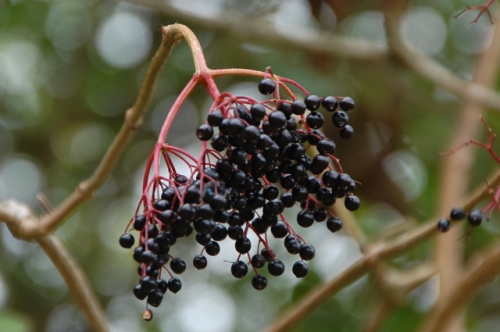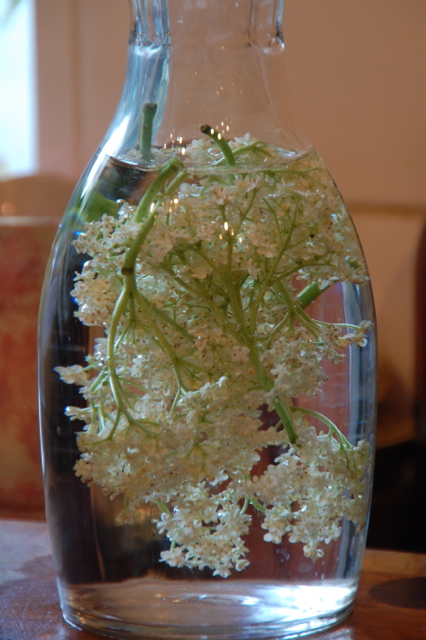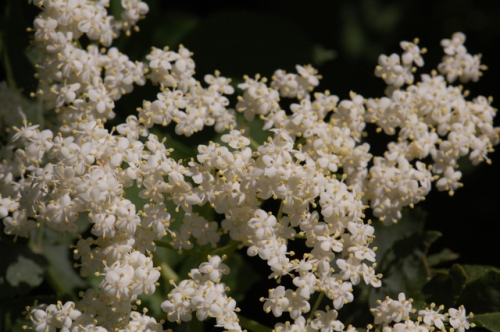Common name: Elderberry
Latin: Sambucus nigra
Family: Adoxaceae
Botanical features: A small deciduous tree or large shrub with leaves in opposite pairs and large corymbs of creamy white flowers in June. The berries turn from green to purplish-black in colour and are held in large drooping clusters.
Key actions of the berries: Antioxidant, anti-rheumatic, anti-viral, diaphoretic, diuretic, hypolipidemic, laxative.
With autumn well underway and the evenings and mornings getting increasingly chilly it’s no wonder that many people are coming down with those mild colds and snuffles that often strike during the change of season.
Possibly the best preventative we have for this time of year is elderberry as unlike many other herbs that are specific for the immune system it seamlessly bridges the gap between food and medicine, making it both easy and enjoyable to include in our everyday diets.
Elderberries are also an important food source for the birds including blackcaps, robins and waxwings.

Green elderberries are never taken internally but were used in the past to make ointments for hemorrhoids.
Undoubtedly using the seasonal gifts of nature in our daily lives can ensure we enjoy our medicine as food and our food as medicine. Country people have always used these edible autumn berries to make preserves, wines, syrups and other delicious preparations that would have helped to keep them well and healthy throughout the winter months.
Elderberry isn’t the most delicious of the berries when eaten raw but a syrup made from elderberry with honey is sure to transport you to a heavenly realm of taste due to its rich, earthy sweetness. Elderberries should not really be eaten raw in any case (though it’s usually fine to sample a few) due to their ability to cause stomach aches, diarrhoea and vomiting. It is always best to cook or tincture them first. You can see some of my elderberry recipes here.
Elderberry is most famous these days for its antiviral and immune tonic effects which are in large part to do with its antioxidant properties. It is also mildly diaphoretic, especially when taken hot as a tea so can help you to sweat out colds and flus. Having a particular affinity for the respiratory system, elderberry will make a lovely tonic for you if colds tend to settle in your chest.
It contains many vitamins and minerals, being especially high in vitamin C and containing appreciable amounts of vitamins A and B6, so it feeds the immune system at the same time as exerting an anti-viral effect. A true ally, elderberry makes you stronger in yourself whilst also fighting at your side. The antioxidants can help stop viruses infecting a cell thus halting the spread of an illness and studies show that taking elderberry shortens the duration of an outbreak of influenza. Laboratory studies show elderberry extracts to be active against numerous strains of influenza but these need to be repeated in human trials before their claims can be substantiated.
Elderberry has an ORAC value of 14697 which is a measurement of the antioxidant capacity of different foods. This makes it one of the highest ranking of the berries, just after chokecherry but above blueberries. Rosehips however have one of the highest values of all being fantastically rich in vitamin C. Back in the 17th century John Evelyn wrote that elderberry extracts would ‘assist longevity’ and of course now we know that antioxidant containing foods are some of the most potent for protecting against premature aging.
Elderberries are particularly rich in antioxidant anthocyanins which are a type of flavonoid that is often found in red, blue or purple foods.
Antioxidants help to heal all our cells and are particularly useful where there is peripheral degeneration such as is commonly seen in diabetes. This most commonly affects circulation to the toes and eyes but a diet rich in antioxidants can help to heal damaged blood vessels and restore function. Elderberry is also thought to be able to lower blood sugar levels making it even more useful, though of course if you take it in a sugary syrup, jam or cordial it negates the effect somewhat! Best stick to tinctures or teas to maximise this property.
A serving of elderberries also contains about 13% of your daily intake of iron which may not seem a massive amount but is helpful when taken with other iron containing foods and herbs, especially as elderberry’s vitamin C content ensures the iron is well assimilated. In fact, Juliette de Bairacli Levy recommends elderberry for iron deficiency anaemia as well as for treating coughs, colds, sore throats and tonsillitis.
Elderberry is both diuretic and mildly laxative making it an all round cleansing remedy which was commonly used in the past for rheumatism and arthritis. According to Mrs Greive “It promotes all fluid secretions and natural evacuations.” Another use for it that has fallen by the wayside in modern times was for treating skin infections and it was no doubt due to it’s mixture of cleansing and immune promoting properties.
Current research is also being done into potential anti-tumour properties of elderberry. The combination of high antioxidant activity, gentle cleansing ability and bio-available nutrients mean it is possibly very useful and it has also been suggested to have anti-angeogenic properties.
There are also studies showing the cardioprotective qualities of elderberry due to its hypolipidemic and antioxidant potential. Natural polyphenol compounds can help to minimise LDL oxidation, LDL being the more harmful type of cholesterol.
There are a few potential interactions to consider when taking elderberry in medicinal doses, though these are at present theoretical. It may lower blood sugar therefore altering the effect of diabetic medications. Also by stimulating the immune system it may interfere with immune suppressing drugs and as a mild diuretic it may have an additive effect with diuretic medications.
Generally consumed in food like quantities however it is a gentle and safe remedy for the whole family and one we should all be taking advantage of at this time of year.




















































